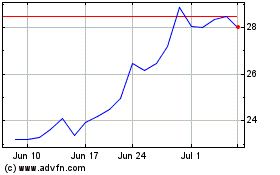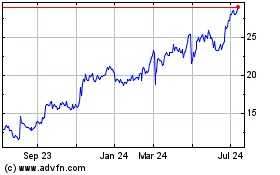UPDATE: For-Profit Schools Could See Bigger Hit From Student Debt Rule
August 16 2010 - 9:53AM
Dow Jones News
A number of for-profit colleges may be in more danger than first
believed of running afoul of a regulation proposed by the U.S.
Department of Education that would force on them harsh penalties
for graduating students with high debt loads, according to data the
agency released late Friday.
The department, in an attempt to show some of the rule's
potential impact were it to be implemented, posted to its website
late Friday a listing of the fiscal 2009 loan repayment rates at
more than 8,000 for-profit schools nationwide.
The numbers, disputed by some institutions as being based on
faulty or unclear calculations, pushed schools' shares down sharply
premarket as investors weighed how it would translate to the
program-level figures on which the rule would ultimately be
based.
Premarket, Strayer Education Inc.'s (STRA) stock was off 16.2%
to $167.54, while Corinthian Colleges was down 12.2% to $5.90.
Shares of ITT Educational Services Inc. (ESI) were down 9.2% to
$58.40, DeVry Inc. (DV) slid 7.2% to $39.65 and Washington Post Co.
(WPO) was down 13.3% to $297.66.
The proposed rule, intended to measure how well for-profit
schools train students for gainful employment in a recognized
occupation, would penalize programs for graduating students with
heavy debt burdens. Schools could "pass" based on student loan
repayment rates, or by maintaining a debt-to-income ratio below a
certain percent.
While a handful of schools have said they think at least most of
their programs would pass the government's proposed hurdles based
on internal calculations, they've warned that programs such as
deferment and forbearance, often championed by the government to
allow students to pursue additional education or take on low-paying
public service jobs, would count as non-repayment under the new
rule.
The newly released data "suggests ineligibility issues are
meaningfully understated for proprietary schools," FBR Capital
Markets analyst Matt Snowling wrote in a note on Monday.
Strayer, which in late July said it believed each of its
programs would clear the department's highest proposed hurdle of
loan repayment by 45% of graduates, scored a 25% schoolwide. The
company had noted last month that it was difficult to measure rates
exactly because loan consolidation complicates the measure of
deferment or forbearance. The school said on a conference call
early Monday that it would file a Freedom of Information Act
request to see some of the data on which the Department based its
calculations, calling the data "inaccurate," nonsensical" and
"arbitrary."
"This discrepancy has significant operational, financial, and
public policy implications," Strayer said in a statement on
Saturday. The school had been considered among the most shielded
from the proposed rule, with a large portion of its students in
bachelor's and graduate degree programs and historically low loan
default rates.
"The fact that [Strayer] had among the lowest repayment rates
among the publicly held group despite having relatively low cohort
default rates leads us to question the validity of this data
series," said Jeff Silber of BMO Capital Markets.
Washington Post Co., whose Kaplan unit had a weighted average
repayment rate of 28%, also expressed concern Monday about the
implications of the department's data. The company said in a press
release that if program-level repayment rates are similar to the
data provided Friday, a significant number of Kaplan schools could
become ineligible for federal student aid, which "could have a
materially adverse effect on the future results of the Company's
higher education division."
Based on Friday's data, Universal Technical Institute Inc.
(UTI), Grand Canyon Education Inc. (LOPE), American Public
Education Inc. (APEI) and Bridgepoint Education Inc. (BPI) had the
highest repayment rates among publicly traded for-profit schools,
all above the 45% threshold. Corinthian Colleges Inc. (COCO),
Washington Post Co.'s Kaplan and ITT Educational Services Inc.
(ESI) were among the lowest performers.
-By Melissa Korn, Dow Jones Newswires; 212-416-2271;
melissa.korn@dowjones.com
CECO Environmental (NASDAQ:CECO)
Historical Stock Chart
From May 2024 to Jun 2024

CECO Environmental (NASDAQ:CECO)
Historical Stock Chart
From Jun 2023 to Jun 2024
